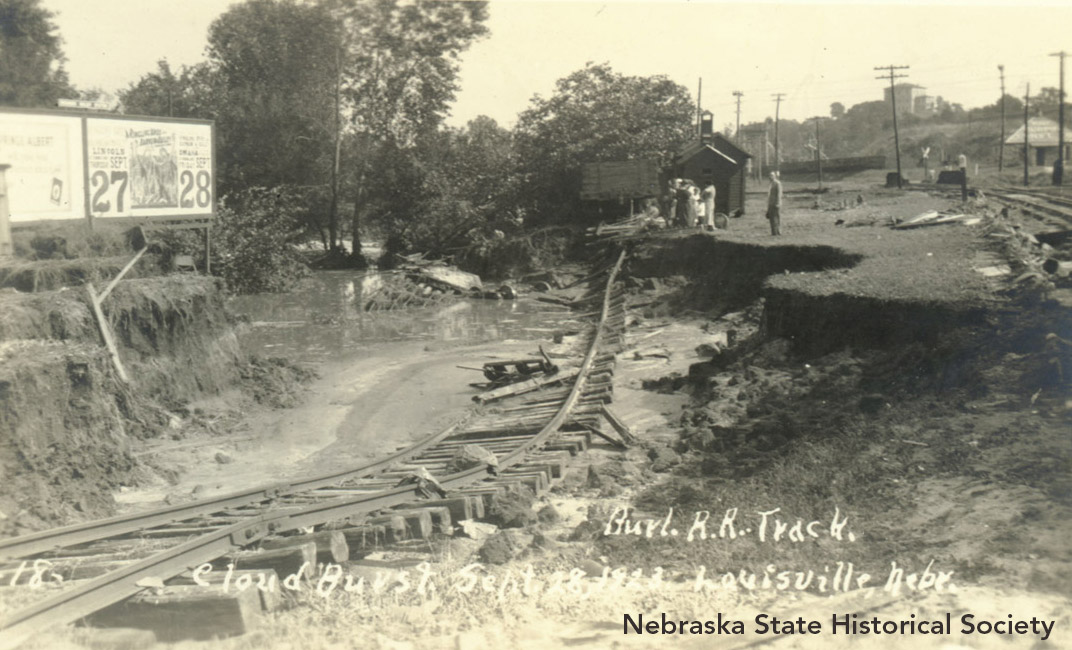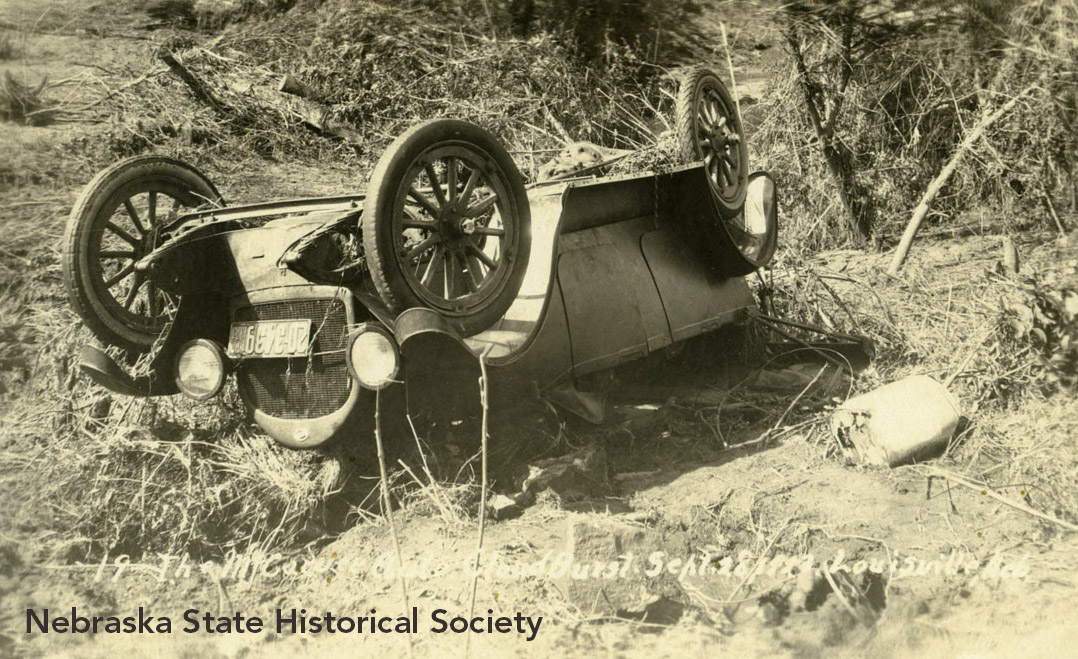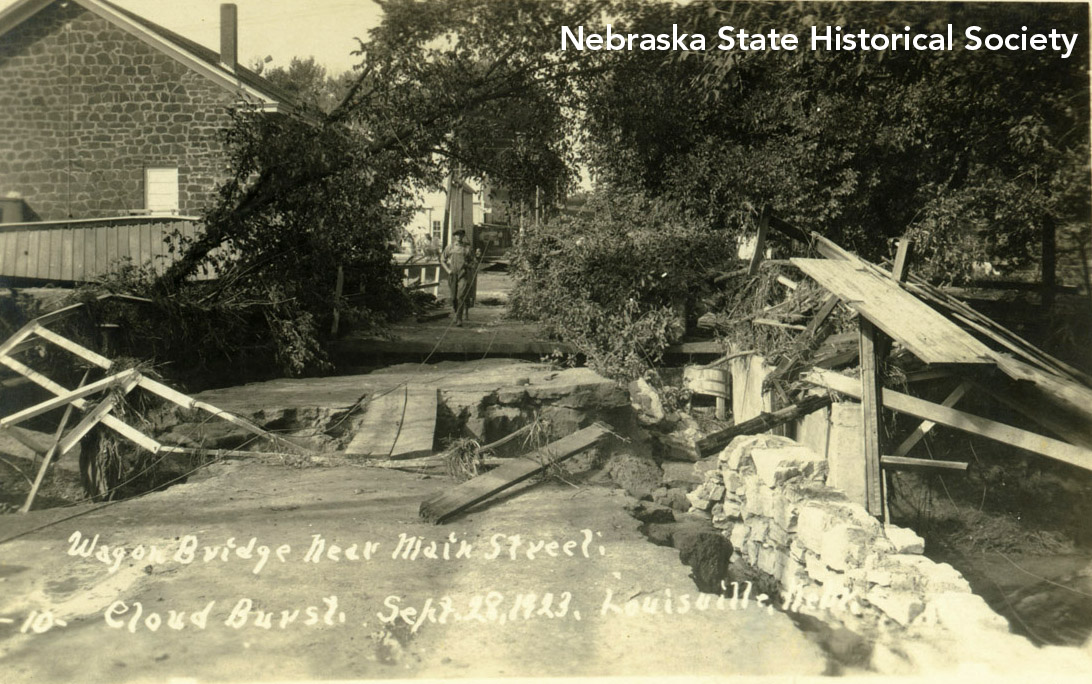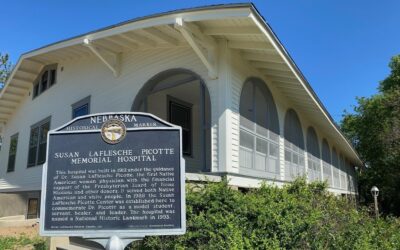 The Burlington Railroad Track after the “Cloud Burst” on Sept. 28, 1923, Louisville, Nebr. RG0802.PH000011-000068
The Burlington Railroad Track after the “Cloud Burst” on Sept. 28, 1923, Louisville, Nebr. RG0802.PH000011-000068
In 1923, Louisville, Nebraska, was having a wild weather summer. In late August, the town survived a “baby Twister” that “wreaked its vengeance in one part of town and a block distant no damage was done” (The Courier, Aug. 31, 1923). The town’s paper, The Louisville Courier, reported: “The band stand at the baseball grounds was wrecked and loose boards flew about promiscuously, yet strange to relate no one was injured” (Aug. 31, 1923). During the same storm, five head of cattle died from lightning and “one of the oldest land marks in town, the Burlington windmill, was so badly damaged by the storm that it will be torn down” Both this article and an article talking about Charles Lau’s “Good Stand of Wheat” mentioned the dry conditions plaguing the area. That dry spell ended September 27, 1923. Rain fell in a torrential downpour for most of the day. Debris began piling up against a bridge south of town, which dammed the waters of Mill Creek. A group of family and friends gathered in a house near Mill Creek after burying the matriarch of the family, Mrs. Susie McCarver. Susie’s sons Robert McCarver and William McCarver and her daughter, only named as “Mrs. Alfred Laird,” were at the house along with Susie’s sister, Mrs. Lou Smith. William’s wife, Rosa, was also at the house with her two daughters from a previous marriage, Pearl and Pauline Brunkow. Mr. and Mrs. Laird had three children there, a little girl and two sons named Herbert and Leonard. A neighbor woman, Mrs. Mary Catherine Morgan, and her young son Clarence were also in the house. The first notice of danger came from water pouring through the doors. William McCarver snatched up his two sons, Alfred Laird grabbed his daughter, and they rushed the children to a neighbor’s house to safety before returning for the other members of their families. Seconds after they entered the door, the house began to move. Floating timbers, trees, and buildings and the near-darkness prevented neighbors from going to the rescue. Onlookers were not sure if the occupants drowned or if the trees and debris crushed the house. All twelve of the house’s inhabitants died. Two of the bodies were never found. The Courier writes, “The unfortunate people were well known in this town and were highly respected and had many friends. Their tragic death has cast a deep pall of mourning over the whole community and loving hands have done all they could for the few surviving members of the families. The town has been sorely stricken but never has there been a word of complaint over the loss of property or even homes. The sympathy of the losers has been entirely with the unfortunate people who lost their lives and with their relatives. The town and all the neighboring towns have spared no effort to search for the bodies not yet recovered and have worn themselves out in their disappointment. We can only trust to time to reveal their resting place” (Oct. 5, 1923).
 A car got caught in the flood following the “cloudburst.” Sept. 28, 1923, Louisville, Nebr. RG3384.PH000004-000022
A car got caught in the flood following the “cloudburst.” Sept. 28, 1923, Louisville, Nebr. RG3384.PH000004-000022
Many of Louisville’s residents lost belongings or their entire homes. Mr. Fred Shelhorn was “negotiating to purchase this place but feels now that he would not care to own a home so near the water” after his house was broken in two. One story tells how three young boys swam to higher ground, miraculously missing the debris that was just as dangerous as the flood waters. The Courier writes, “fortunately all the boys in Louisville are good swimmers, having learned in the sand pits here and the little fellow swam right along behind his brothers” (Oct. 5). Another older couple refused to be rescued when the water was waist height because “they were nervous about leaving their home and hardly though it would get worse.” The water filled their house, and Mrs. Schoeman, aged 75, climbed to the top of the furniture and waved lit matches out of the window until a group of boys rescued her and her husband. The Dehning family also had a close escape. Mr. Dehning left work when the flood began, but the roads were covered in water. Desperate to reach his family, he crawled along the railroad tracks only to find the street he lived on to be dark and impassable. He “had about given his family up for lost. It seemed impossible that they could have survived such a rush of water…” Meanwhile, his wife, three-year-old-son, and sister had left the house when the waters began to rise. On the way, “Mrs. Dehning was carrying her baby and was struck by a floating telegraph pole and knocked down and how she ever got up is more than she can tell now…” The family reached the safety of higher ground and was reunited with Mr. Dehning later. A freight train was stranded on the washed out tracks, but “turned on their headlights for the rescuing parties and this was all that made it possible for the rescuers to enter the raging waters.” One woman was rescued from the attic of her home along with her two young sons. Many residents gathered in the Drake Hotel, which had a higher foundation than many of the other buildings. This is also where The Courier editor and his wife took refuge. He writes, “The beating rain, the rush of the water around the corner of the hotel and the crashing of floating timbers and wreckage made a sound of destruction that cannot be described and this together with the fear of what was taking place on the lower land and the danger of the collapse of the hotel, because of the cellar full of water and the rush of the flood against the building – all this has be experienced to be fully appreciated.” During the entire flood, Marjorie Twiss and Lyida Pautsch, the town’s telephone operators, remained at their posts nearly all night and were later lauded as “a couple of heroines” for the work.
 Wagon bridge near Main Street after “cloud burst.” Sept. 28, 1923. Louisville, Nebr. RG3384.PH000004-000024
Wagon bridge near Main Street after “cloud burst.” Sept. 28, 1923. Louisville, Nebr. RG3384.PH000004-000024
Another remarkable detail is the way this disaster brought previous residents flooding back to the town to visit friends and relatives. The Courier ran an entire page of “personal paragraphs” detailing all of the visitors and their activities, many of whom arrived “to spend the day with old friends and neighbors and express sympathy for them and to look over the wreckage of the former homes here carried away by the flood waters” (Oct. 12, 1923). Businesses ran ads in the paper expressing their sympathy, and a grocery store was still running a “flood sale” until October 19. Unfortunately, thefts were reported along with the reports of bravery and generosity. The Courier writes, “Special police have been put on and night watchmen patrol the stricken district and thieves will be dealt with as they deserve if apprehended” (Oct. 5, 1923). In addition, The Courier reported on October 19 that “no more money is needed for relief. Unsolicited by the people of Louisville, funds have rolled in from all sources in amounts from $1 to $500 for the sufferers from the flood…” The Courier later became a lost-and-found of sorts, even publishing photos that had been found in the debris and turned in to the office (Oct 12). In the issue after the flood, The Courier called the event the “Greatest Calamity in History of Louisville – Sudden Flood Kills Twelve and Carries Away Homes as if They Were Leaves.” Along with its detailed coverage, it was also somber and philosophical in tone: “Last Friday night’s storm demonstrated the helplessness of man against the unconquerable elements of wind and water.”



